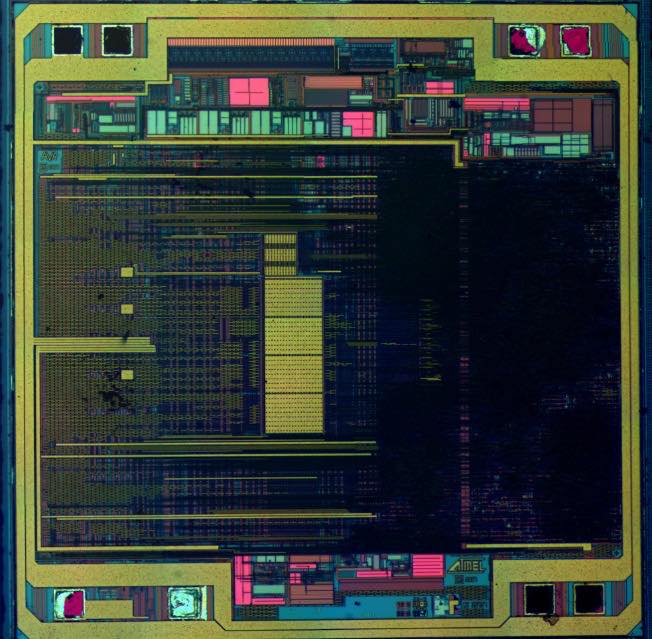Unlock IC AT89C51RD2 Flash
Unlock IC AT89C51RD2 Flash memory can help engineer to recover secured MCU memory firmware, and then extract heximal file from microcontroller at89c51rd2 eeprom memory;

AT89C51RD2/ED2 is high performance CMOS Flash version of the 80C51 CMOS single chip 8-bit microcontroller. It contains a 64-Kbyte Flash memory block for code and for data.
The 64-Kbytes Flash memory can be programmed either in parallel mode or in serial mode with the ISP capability or with software. The programming voltage is internally generated from the standard VCC pin if reading microcontroller pic12c509a bin .
The AT89C51RD2/ED2 retains all of the features of the Atmel 80C52 with 256 bytes of internal RAM, a 9-source 4-level interrupt controller and three timer/counters. The AT89C51ED2 provides 2048 bytes of EEPROM for nonvolatile data storage.
In addition, the AT89C51RD2/ED2 has a Programmable Counter Array, an XRAM of 1792 bytes, a Hardware Watchdog Timer, SPI interface, Keyboard, a more versatile serial channel that facilitates multiprocessor communication (EUART) and a speed improvement mechanism (X2 Mode) after crack pic12ce519 flash memory .
The fully static design of the AT89C51RD2/ED2 allows to reduce system power consumption by bringing the clock frequency down to any value, including DC, without loss of data.
The AT89C51RD2/ED2 has 2 software-selectable modes of reduced activity and an 8-bit clock prescaler for further reduction in power consumption. In the Idle mode the CPU is frozen while the peripherals and the interrupt system are still operating. In the Power down mode the RAM is saved and all other functions are inoperative.
The added features of the AT89C51RD2/ED2 make it more powerful for applications that need pulse width modulation, high speed I/O and counting capabilities such as alarms, motor control, corded phones, and smart card readers before crack mcu pic16c642 bin.
The Special Function Registers (SFRs) of the AT89C51RD2/ED2 fall into the following categories:
C51 core registers: ACC, B, DPH, DPL, PSW, SP
I/O port registers: P0, P1, P2, P3, PI2
Timer registers: T2CON, T2MOD, TCON, TH0, TH1, TH2, TMOD, TL0, TL1, TL2,
RCAP2L, RCAP2H
Serial I/O port registers: SADDR, SADEN, SBUF, SCON
PCA (Programmable Counter Array) registers: CCON, CCAPMx, CL, CH, CCAPxH,
CCAPxL (x: 0 to 4) after Unlock IC
Power and clock control registers: PCON
Hardware Watchdog Timer registers: WDTRST, WDTPRG
Interrupt system registers: IE0, IPL0, IPH0, IE1, IPL1, IPH1
Keyboard Interface registers: KBE, KBF, KBLS
SPI registers: SPCON, SPSTR, SPDAT
BRG (Baud Rate Generator) registers: BRL, BDRCON
Clock Prescaler register: CKRL when Unlock IC
Others: AUXR, AUXR1, CKCON0, CKCON1
AT89C51RD2/ED2 I/O ports (P1, P2, P3, P4, P5) implement the quasi-bidirectional output that is common on the 80C51 and most of its derivatives. This output type can be used as both an input and output without the need to reconfigure the port. This is possible because when the port outputs a logic high, it is weakly driven, allowing an external device to pull the pin low when Unlock IC .
When the pin is pulled low, it is driven strongly and able to sink a fairly large current. These features are somewhat similar to an open drain output except that there are three pull-up transistors in the quasi-bidirectional output that serve different purposes. One of these pull-ups, called the “weak” pull-up, is turned on whenever the port latch for the pin contains a logic 1. The weak pull-up sources a very small current that will pull the pin high if it is left floating. A second pull-up, called the “medium” pull-up, is turned on when the port latch for the pin contains a logic 1 and the pin itself is also at a logic 1 level before Unlock IC .
This pull-up provides the primary source current for a quasi-bidi-rectional pin that is outputting a 1. If a pin that has a logic 1 on it is pulled low by an external device, the medium pull-up turns off, and only the weak pull-up remains on. In order to pull the pin low under these conditions, the external device has to sink enough current to overpower the medium pull-up and take the voltage on the port pin below its input threshold after Unlock IC .
Tags: unlock ic heximal archive,unlock ic heximal code,unlock ic heximal content,unlock ic heximal data,unlock ic heximal eeprom,unlock ic heximal file,unlock ic heximal firmware,unlock ic heximal information,unlock ic heximal memory,unlock ic heximal program

